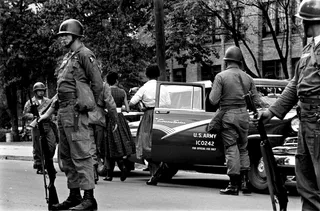School Segregation Then and Now: Has Much Changed?
A look at desegregation efforts since Brown v. Board.

1 / 9
School Segregation Then and Now: Has Much Changed? - On May 17, 1964, the U.S. Supreme Court ruled that segregation of public schools was illegal in the case of Brown v. Board of Education. The Little Rock Nine, Ruby Bridges and other Black students became the faces of this new era. Take a look at how school districts handled desegregation efforts sixty years since then. — Natelege Whaley (Photo: National Archive/Newsmakers/Getty Images)

2 / 9
Boston Public Schools - Before Brown v. Board of Education, Sarah Roberts, 5, was denied enrollment in a white school in Boston in 1848. The Massachusetts Supreme Court banned segregation in the state in 1855. In the 1970s, Black students in the city were forced to be bused to white areas and white students to Black neighborhoods. As of 2013, the district has ended busing. (Photo: Bill Greene/The Boston Globe via Getty Images)

3 / 9
Topeka, Kansas, Public Schools - In 1951, Oliver Brown filed a lawsuit against Topeka, Kansas, school board for denying his child access to a white school. It became the class-action suit that led to the desegregation of schools around the country. Today, Topeka, Kansas, public schools are 19 percent African-American and 41 percent white. (Photo: National Park Service)

4 / 9
Little Rock, Arkansas - In 1957, nine Black students were the first to attend Little Rock, Arkansas’ Central High School. The district implemented the "Blossom Plan" that allowed Black students to transfer to any school where they would be the minority. In January 2013, a judge ruled the school district desegregated therefore ending state funding for the issue. (Photo: Lloyd Dinkins/Commercial Appeal /Landov)
Photo By Lloyd Dinkins/Commercial Appeal /Landov

5 / 9
Edward County Public Schools, Virginia - Rather than integrate Black students, Edward County Public Schools shut down all of their schools in 1959. Private schools were opened to educate white students. Black children did not have access to education until the U.S. Supreme Court reopened schools in 1964. Today, 34 percent of Black students attend Prince Edward County schools, which is proportionate to the overall Black population. (Photo: Roger L. Wollenberg/UPI Photo/Landov)
ADVERTISEMENT

6 / 9
New Orleans - Ruby Bridges became the first Black child to attend an all-white elementary school in the South in New Orleans in 1960. As of 2009, 78 percent of African-American students in the New Orleans metropolitan area attended non-white segregated schools and 99 percent of them were classified being high poverty. (Photos: Times-Picayune /Landov)

7 / 9
University of Mississippi - Riots broke out as James H. Meredith was escorted to the University of Mississippi as the first African-American to attend the school on Oct. 1, 1962. Fifty years later on the night of President Obama’s re-election, the campus broke out in a riot with a crowd of 500 “agitated and angry” students shouting racial slurs and setting off fireworks near the Minority Student Union. (Photo: Marion S. Trikoso/Tehrkot /Landov)

8 / 9
Louisville, Kentucky - In 1971, Louisville and Jefferson County school systems were hit with a lawsuit calling for them to be desegregated. In 1996, a court ruled that every school had to have a 15 to 50 percent Black student enrollment. The Supreme Court struck down that ruling in 2007 and under a new plan, the districts are focusing more on class than race in assigning students to schools. (Photo: Luke Sharrett/Getty Images)
